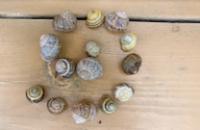
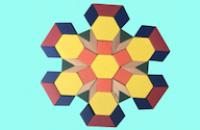
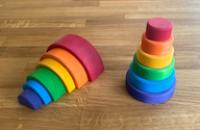
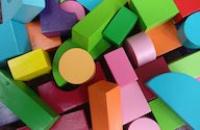
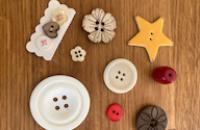
Children often enjoy combining block play with small world items and talking about what they have made. Later this may include planning what they will make and telling a 'story' about what is happening in their 'house' or 'boat', for example.
Adults could provide photographs or images of completed patterns or arrangements of toys to copy for themselves (in block play, pattern blocks, mosaic tiles or coloured cubes for example).
The Activity
Each player needs the same small collection of blocks and small world toys. One player (the Builder) creates an arrangement with their toys. The Builder tells a second player (the Maker) how to make their arrangement exactly the same. Swap roles.
Once this idea is understood, introduce a 'barrier' such as an upstanding book, to hide what the Builder is making from the Maker. The Maker has to create the same arrangement without seeing it (you could offer a glimpse to begin with), which encourages use of precise vocabulary.
Encouraging mathematical thinking and reasoning:
Describing
What do you notice about these two collections? Are you sure you both have exactly the same collection to start? How do you know?
What is the same? What is different?
Reasoning
How did you decide to place that (piece) there? What did you hear Ivy say to make you place that there?... that way around? What words helped you know where to put it?
Are the two exactly the same? Are you sure? How do you know?
What if... we turn that one around? Or move it next to the cow?
Which positions are the most tricky to describe? What makes an arrangement easier or harder?
Opening Out
What if … we try this with Pattern Blocks? … mosaic tiles? … big blocks/boxes outside?
What if … we try playing this with one Builder and a group of friends as Makers?
What if … we try this without using a specific word (e.g. 'behind')
Recording
Take photographs of the arrangements to discuss and try and re-make.
Provide children with clipboards to draw their arrangement of toys. You might even try drawing the arrangements from a different viewpoint (e.g. what the cow can see).
The Mathematical Journey
Shape, space and position:
- recognise similarity and difference in shapes and objects
- visualise what objects will look like in different positions and orientations
- begin to imagine what objects will look like from someone else's viewpoint (perspective-taking)
- understand and use shape, position and direction words, such as: on top, underneath, behind, turn it over, the other way around, next to, in front, beside, across
Measures:
- begin to use and understand time vocabulary relating to sequencing and order, such as: first, next, then, after
Number:
- using counting to check that each player has the same number of pieces in order to play and when the arrangement is complete.
Development and Variation
- Once the rules of the game are understood, this can be played with as many different resources as you can imagine, large and outdoors as well as smaller and indoors. Ask the children what they would like to play it with.
- Can they 'make it the same' without giving the Maker an initial glimpse and without them looking until the Builder is satisfied the whole arrangement is complete?
- Try playing with structured resources such as Numicon, pegboards and pegs, as well as unstructured natural materials such as a collection of twigs, leaves and pebbles.
- Try a variation where the Builder places one item at a time for the Maker to follow-their-lead.
- Try starting with both arrangements built. The Builder becomes The Changer and describes how they have changed their arrangement to The Maker for them to follow.
Resources

To begin with, two identical small collections of small world toys to make an arrangement and a 'barrier' such as an upstanding book.
Acknowledgement: Helen J. Williams

